Excerpts from Jim Conrad's
Naturalist Newsletter
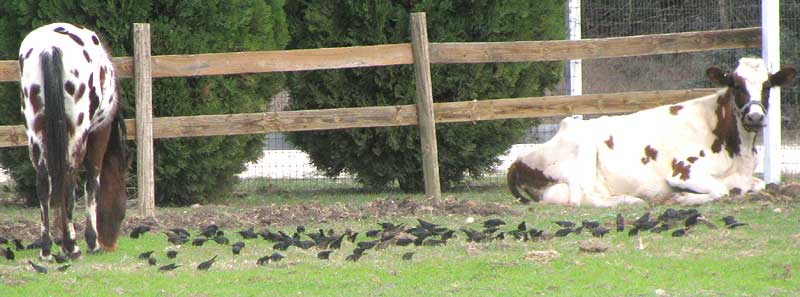
from the March 31, 2013 Newsletter issued from the Frio Canyon Nature Education Center in northern Uvalde County, southwestern Texas, on the southern border of the Edwards Plateau; elevation ~1750m (~5750 ft); N29.62°, W99.86°; USA
COWBIRD FLOCK
Hearing a familiar quick, upward rising, bubbly, fluty bird call, I looked up and saw a nearby treetop blackened with dozens of stocky, black birds. The call must have been a signal to move on because the moment I focused on them the whole flock launched from the tree, made a big circle over the neighbor's pasture, and landed next to Minnie the Cow and the unnamed pony, as you can see above.
From the up-swinging, bubbly, fluty call and behavior I knew that at least some of the birds, if not all, were Brown-head Cowbirds. During the winter this species often flocks with other blackbird species and starlings, but in the picture I can only find thick-necked, short-tailed, heavy-set Brown-headed Cowbirds, so maybe this is a pure cowbird flock migrating northward. I've not seen such a flock all winter. Some Brown-headed Cowbird flocks are much larger than this one. The Cornell Lab of Ornithology's page on the species mentions a cowbird flock in Kentucky of over five million birds.
As we detail below, Brown-headed Cowbirds are nest parasites. A detailed look at cowbird influence on songbirds is presented at http://faculty.ncwc.edu/mbrooks/pif/Fact%20Sheets/Cowbirds.htm.
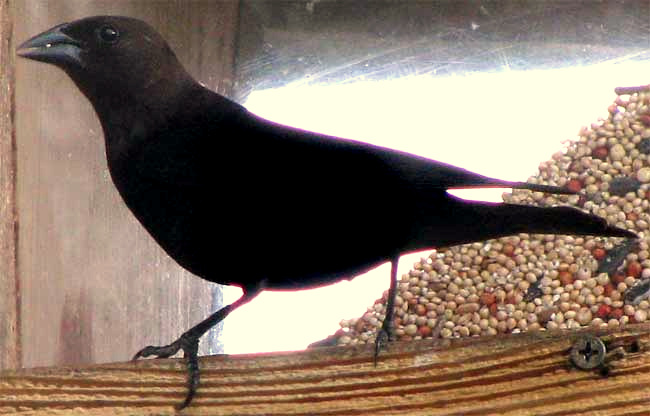
from the the March 31, 2002 Newsletter, issued from near Natchez, Mississippi:
BROWN-HEADED COWBIRD MORALITY
Thursday morning as I prepared my campfire breakfast, four blackish, dumpy-looking birds landed in the top of a nearby Pecan tree. They made squeaky gurgling calls and fluttered in a curious way so even without binoculars I knew I had four Brown-headed Cowbirds.
I watched as three males orbited around a female displaying. During the "Bill-Tilt Display" a male would lift his head and point his bill skyward. This would often be followed by the "Topple-Over Display," during which the bird would fluff his body feathers, arch his neck, spread his tail and wings, and sort of lurch forward, sometimes issuing the gurgling song. Apparently these displays excite females, and probably females choose to mate with males doing the best job. The above Web address goes into more detail about these and other cowbird displays.
Female cowbirds do not lay eggs in their own nests. Being careful to go unobserved, sneaking quietly through undergrowth or among dense leaves, they look for the nests of birds of other species. Often they locate nests still under construction. Then the female cowbird watches the nest until egg laying begins, and one dawn she sneaks in, removes and sometimes eats the nest-owner's egg, and lays her own. If only one "host" egg is present, she does not remove it, apparently because doing so might clue the nest owner that something is amiss, and the nest might be abandoned.
Not only do cowbird eggs usually hatch one day ahead of the host's eggs, but also cowbird nestlings typically are larger, are more aggressive in begging for food, and grow faster than the host's own young. Even when the cowbird fledgling grows much larger than the host mother herself, the mother just doesn't catch on that there's a problem.
Of course this is hard on "host" families. Before humans began cutting up the landscape, cowbird "nest parasitism" wasn't as important as it is now because cowbirds in most places tend to focus their activities in open areas and forest edges. However now humans have broken vast forests into tiny plots and there are so many access roads that many remaining forests consist of nothing but "ecological edges." Cowbird nest parasitism is a very serious problem contributing to the ongoing collapse of many bird populations. Species hurt particularly hard include the Song Sparrow, Chipping Sparrow, Eastern Phoebe, and Northern Cardinal.
How can Mother Nature tolerate such a free-loading species?
Maybe we just have to recognize that Nature rejoices over diversity to the same extent that She doesn't really care much whether individuals like you and me get exactly what we want. Nature exults in the robust feeling embodied in the music, not in the destinies of us individual notes comprising the score.
from the June 27, 2009 Newsletter, issued from the Siskiyou Mountains west of Grants Pass, Oregon:
COWBIRD VILLAINY?
Before Europeans arrived in North America, cowbirds followed enormous herds of buffalo as the buffalo constantly moved from one grazing ground to another. You can see how nest parasitism would develop in a bird species needing to be on the move all the time, and why cowbirds would choose host nests at forest edges, where they could have trees yet also be close to the buffalo. As cowbird nest parasitism evolved, the reproductive rates of other bird species gradually increased to compensate for their nesting losses.
However, once the great forests were broken into today's tiny woodlots, vast acreages became "forest edge" habitat very inviting to cowbirds. Now, cowbird nest parasitism affects a much greater percentage of songbird nests than in the past. My picture of a male displaying while issuing his upward swinging bubbling call before a female almost has a slightly degenerate, villainous feeling to it, as you can see below:
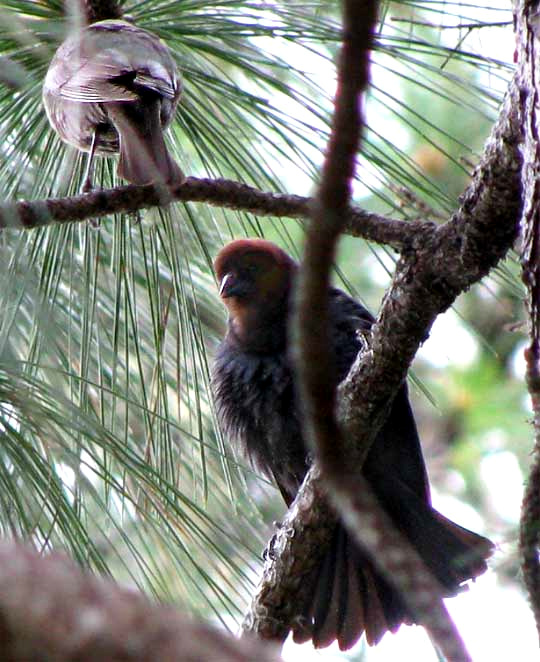
However, the effects of cowbird nest parasitism vary locally. A study in canyon woodlands around Fort Hood, Texas found that 90% of all Black-capped Vireo nests were parasitized, and that clearly was bad news for Black-capped Vireos. Yet in California's Sacramento River watershed where 83% of Lazuli Bunting nests were parasitized, the buntings' nests were no less successful than nonparasitized ones. Often parasitized nests are abandoned and renesting takes place. A well documented Audubon page discussing many sides of the issue is at http://www.audubon.org/bird/research/.
from the April 27, 2014 Newsletter issued from the Frio Canyon Nature Education Center in the valley of the Dry Frio River in northern Uvalde County, southwestern Texas, on the southern border of the Edwards Plateau; elevation ~1750m (~5750 ft); N29.62°, W99.86°; USA
CONFRONTATIONS
All winter my bird feeder was visited almost exclusively by Chipping Sparrows and Black-crested Titmice, with a Cardinal couple making occasional quick visits. About a month ago House Finches appeared, just a few at first but now they're the main species at the feeder. The sparrows and titmice come daily, but in much fewer numbers. This week, Brown-headed Cowbirds have appeared for the first time.
When a cowbird arrives at the feeder, smaller sparrows and titmice normally fly away, but sometimes a finch tries to hold his ground. Below, you can see a male House Finch gamely trying to face down his opponent -- for about a second before losing his footing, fluttering flounderingly and flying away -- as the much larger male cowbird imperiously adds to his height by lifting his head as if about to thrust downward:
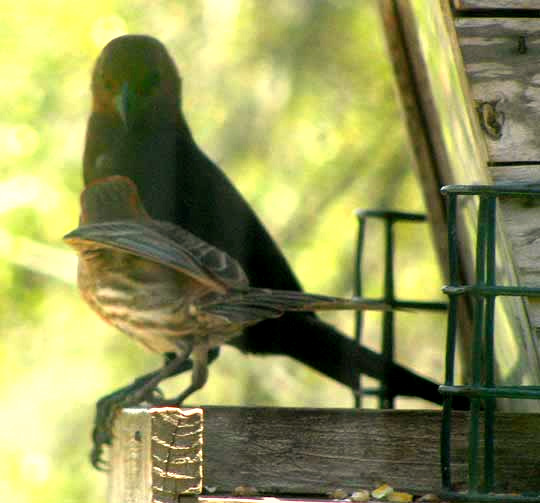
It's hard to say whether the bird feeder's changing visitor profile is due mostly to seasonal behavioral shifts among the species, or whether it's simply a matter that with time the more aggressive species are gradually taking over. The picture suggests that at least some of the later is happening.
from the June 16, 2013 Newsletter issued from the Frio Canyon Nature Education Center in northern Uvalde County, southwestern Texas, on the southern border of the Edwards Plateau; elevation ~1750m (~5750 ft); N29.62°, W99.86°; USA
COWBIRD EGG IN PHOEBE NEST
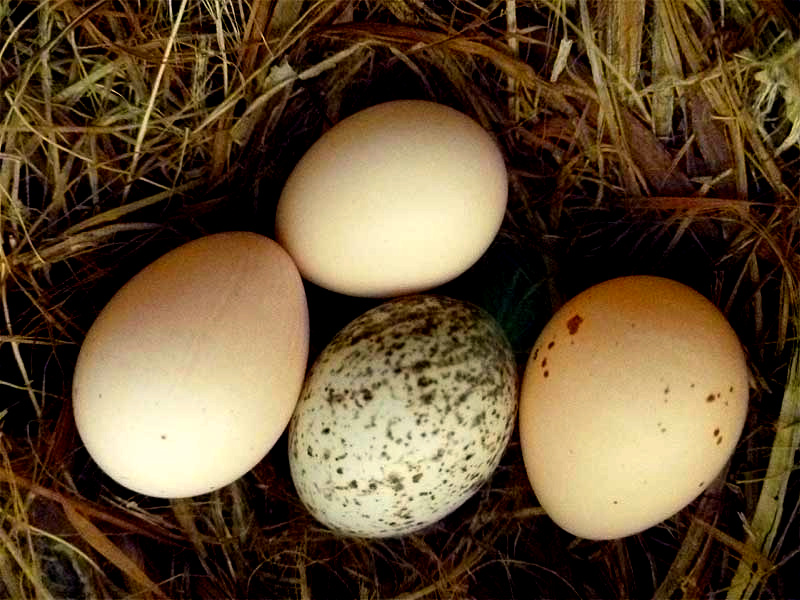
Last week we looked at a nest of a pair of Eastern Phoebes on my neighbor Phred's back porch. This week, wanting to see if eggs had been laid, I pressed a downward-pointing camera against the porch ceiling about three inches (8cm) above the nest and took the picture shown above.
Eggs of the Eastern Phoebe are about ¾ inch long (2cm) and normally are white, sometimes speckled with reddish brown. But they're not as speckled as the very speckled egg in the center. That center egg, which also lacks the other eggs more pointed end, is an egg of the Brown-head Cowbird. Cowbird eggs are described as having a ground color varying from an almost pure white to grayish white, or sometimes pale bluish or milky white, with specks and blotches varying from brown or tawny to reddish brown.
Nests of Eastern Phoebes are known to be particularly heavily parasitized by Brown-headed Cowbirds. The female cowbird spots another bird species, such as our phoebes, building a nest, then the cowbird lays a single egg -- rarely more -- in the "host nest." The female cowbird may remove or destroy one of the original nest eggs. Sometimes the parents in whose nest the cowbird has laid her egg recognize that there's a problem and remove the cowbird egg, or build a new nest over the old nest, or abandon the nest entirely. Usually, though, the adopted parents continue with their nesting as if nothing has happened. Cowbird eggs normally hatch before other eggs in the nest. The cowbird nestling typically is larger than the other nestlings and grows so much faster that sometimes the smaller nestlings are crowded from the nest. The cowbird nestling may so aggressively beg for food that other nestlings starve.
Cowbirds mostly inhabit forest edges. During most of songbird evolution, forests were extensive with relatively limited "edges," so cowbird nest parasitization wasn't a huge problem. However, nowadays forests are so fragmented into tiny parcels that nearly everything is "edges," and the effect of cowbirds is more pronounced than before.
Still, a good case can be made that various "cowbird control programs" are useless and ethically questionable. A good discussion of the issue is provided in a PDF document you can download from the American Birding Association after using a search engine on the title "Brown-headed Cowbird: Villain or Scapegoat?"
That document argues that the effects of cowbirds are negligible in comparison to habitat destruction. That's a point I heartily agree with.